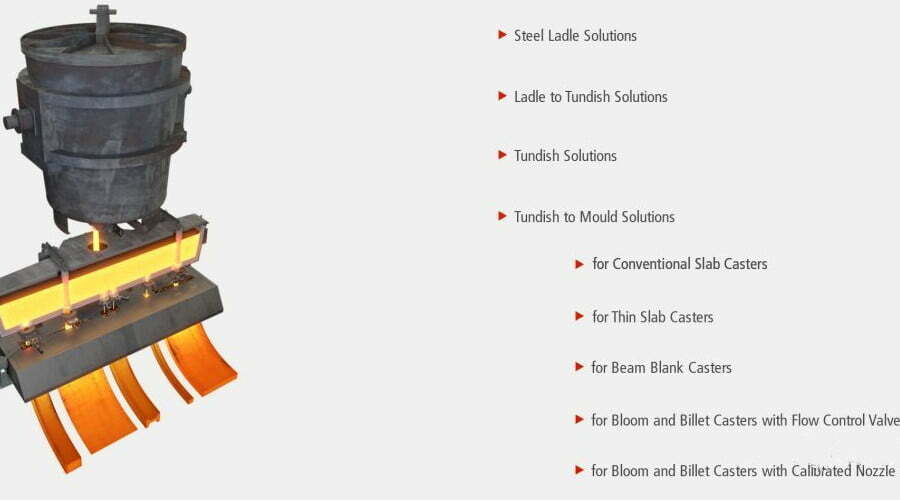The continuous casting machine process is the intermediate link between steel making and rolling, and is an important part of a steel-making plant (or workshop). The continuous casting machine process is ladle → tundish → crystallizer → secondary cooling → billet straightening → cutting → roller conveyor → pusher → billet casting.
The application of continuous casting technology has completely changed the production process and logistics control in the steel-making workshop and provided conditions for the continuous production, automation, and application of information technology in the workshop, as well as for greatly improving the environment and improving the product quality.
In addition, the development of continuous casting technology will also drive the development of other industries in the metallurgical system, and play an important role in promoting the simplification and optimization of enterprise organizational structure and product structure.
1. Characteristics of the Continuous Casting Machine Process
The continuous casting machine process is a process in which the molten steel releases sensible heat and latent heat in a continuous state and gradually solidifies into a certain shape of a billet. During the transformation of steel from liquid to solid, there are momentum, heat and mass transfer, phase transformation, and deformation caused by external force and stress in the system. These processes are very complex and often coupled or interact with each other.
Compared with the die-casting blooming process, the continuous casting process has the following advantages:
(1) The process flow of casting billet production is simplified, and the demoulding, whole mold, ingot soaking, and billet opening processes of the mold casting process are eliminated. The capital investment can be saved by 40%, the floor area can be reduced by 30%, the operation cost can be saved by 40%, and the consumption of refractory materials can be reduced by 15%.
(2) The metal yield is improved, and on the one hand, the head and tail loss of the billet is greatly reduced; On the other hand, the billet produced is closer to the shape of the final product, eliminating the heating and blank opening process of the mold casting process, reducing the metal loss and improving the metal recovery rate by about 9%.
(3) The energy consumption in the production process is reduced, the combustion power consumption of the ingot blooming soaking pit can be saved, and the energy consumption can be reduced by 1/4-1/2.
(4) It improves the mechanization and automation level of the production process, and creates favorable conditions for the improvement of labor productivity and the modernization and management upgrading of the enterprise.
2. Development of Continuous Casting Technology in China
China is the first country in the world to study and apply continuous casting technology. Since the 1950s, research on continuous casting technology has been started. In the early 1960s, it entered the industrial application stage of continuous casting technology. However, from the late 1960s to the late 1970s, the continuous casting technology almost stagnated. Statistics in 1982 show that the average continuous casting ratio in the world is about 30%, while that in China is only 6.2%. After the 1980s, China’s continuous casting technology entered a new development period, and a batch of advanced billet, slab, and horizontal continuous casting machine were introduced from abroad. In the mid-1980s, China had the first full continuous casting steel plant – the Second Steelmaking Plant of WISCO. In recent years, China’s continuous casting technology has developed rapidly. By 2005, all provinces (cities and autonomous regions) except Hainan, Ningxia, and Tibet had continuous casting production, and the continuous casting ratio has reached 97.5%.
China is one of the countries that developed thin slab continuous casting technology earlier and has made major breakthroughs in the three core technologies of thin slab continuous casting mold, submerged nozzle and mold flux. The thin slab continuous casting mold with double arc, elliptical and conical inner cavity surface has been developed and used in industrial production.
3. Prospect of Continuous Casting Technology
In terms of production capacity, with the industrialization of electromagnetic combined mold, nonsinusoidal vibration, soft reduction, and solidification dynamic control technology, the output of slab caster reaches 2 million tons/flow/year, and the output of billet caster reaches 400000 tons/ flow/year, forming a production process of single caster to the single continuous rolling mill. In terms of variety structure, with the application of electromagnetic technology and solidification control technology, continuous casting varieties will be expected to achieve 100% of varieties, and realize organization control, and internal and surface quality control, so as to achieve efficient production of defect-free billets. In terms of electromagnetic continuous casting, with the development of superconducting technology, it will be possible to industrialize the electromagnetic confinement crystallizer and electromagnetic vibration excitation device used for casting steel. On this basis, it is expected to develop a continuous casting machine with no mold, no vibration, and an arbitrary combination of section shapes.

